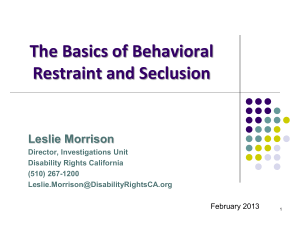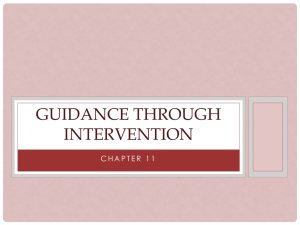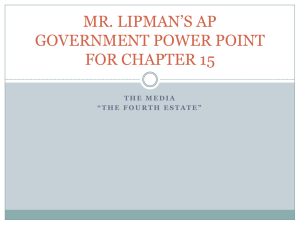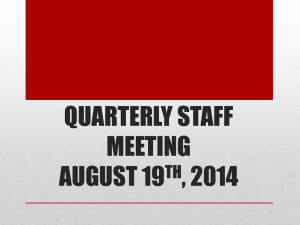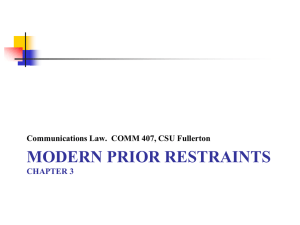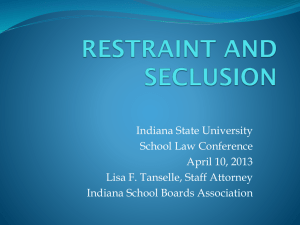Use of Restraints / Seclusion
advertisement
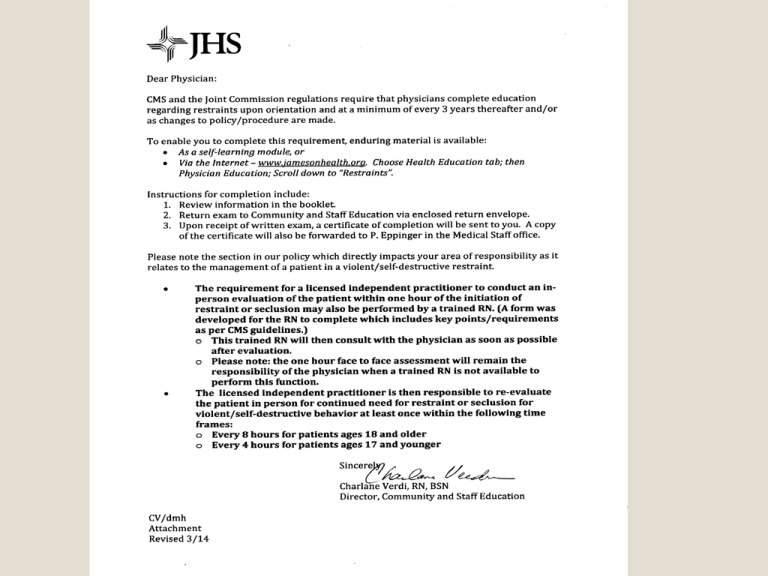
Restraints What is a restraint? A restraint is any manual method, physical or mechanical device, material or equipment that immobilizes or reduces the ability of a patient to move his or her arms, legs, body or head freely; or A drug or medication when it is used as a restriction to manage the patient’s behavior or restrict the patient’s freedom of movement and is not a standard treatment or dosage for the patient’s condition. What is seclusion? The involuntary confinement of a patient alone in a room or area from which the patient is physically prevented from leaving; usually in a locked room. May only be used for the management of violent or self-destructive behavior that jeopardizes the immediate physical safety of the patient, a staff member, or others. What is a Chemical Restraint? A drug or medication used as a restriction to manage the patient’s behavior or restrict the patient’s freedom of movement Used to control or inhibit onset of violent or destructive behavior It is not a standard treatment or dosage used for the patient’s condition Two Types of Restraints NOTE: The type of restraint is not specific to the setting the patient is in, but to the situation the restraint is being used to address. Two Types of Restraints (cont) Violent/Self Destructive Restraint ◦ Used to protect the patient against any injury to self or others because of an emotional or behavior disorder. ◦ Sudden onset of violent aggressive behavior that presents imminent risk of harm to self and/or others. Two Types of Restraints (cont) Non-Violent, Non-Destructive Restraint ◦ Patient condition/behavior meets parameters of protocol Invasive line/tube in place Patient attempts to pull line/tube observed Patient confused/unable to be redirected Alternatives tried and failed Two Types of Restraints (cont) Non-Violent, Non-Destructive Restraint ◦ The primary reason for use directly supports the medical healing of the patient ◦ The patient’s behavior is non-violent and nonaggressive Guiding Principles for the Use of Restraint/Seclusion: Patients are free of restraint and/or seclusion, unless these interventions are medically necessary to promote healing. Measures to protect the patient and others are needed due to violent/ destructive behavior. Guiding Principles for the Use of Restraint/Seclusion (cont): Special care should be taken in assessing the need for restraints and seclusion in special patient populations such as children, adolescents, the elderly, the disabled, and abused patients. The use of restraint/seclusion will be addressed in the patient’s plan of care and/or treatment plan. Alternatives to Restraint/Seclusion Use Alternatives to restraint must be tried prior to placing a patient in restraints: Speak calmly in a reassuring voice Treat patient in a dignified and respectful manner Assess comfort level Assess physical care needs (bathroom, hungry, thirsty . . . ?) Is medication intervention necessary Explain procedures and assess understanding Redirect Alternatives to Restraints (cont). Monitor patient closely to provide safety Play soothing music Place patient in hall or close to nursing station Utilize a safe diversional activity (folding washcloths/activity box) Use verbal redirection techniques and deescalation techniques Decrease environmental stimuli Alternatives to Restraints (cont). Allow wondering, if possible Obtain a low bed/mattress Initiate a PT/OT referral Utilize a bed/chair alarm Use a sitter or obtain assistance from family as appropriate Restraint Application The following restraints are listed from least restrictive to most restrictive Show of support Medication Seclusion 3-4 siderails Mitts (2) Freedom splints (2) Geri-chair Soft-limb restraint (2 extremities) Locked restraints Patient Monitoring Respiratory and circulatory status Skin integrity Assessment of signs of injury Hygiene and elimination needs Nutrition and hydration needs Exceptions The following are NOT governed by the restraint policy and are NOT considered to be a restraint Exceptions to Restraints Handcuffs/other devices applied by law enforcement Orthopedically prescribed devices Methods that involve holding or positioning patient to examine or treat them or protect them from falling Surgical dressings or bandages NEW USE OF WEAPONS CMS does not consider the use of weapons in the application of restraint or seclusion as a safe, appropriate health care intervention. For the purposes of this regulation, the term “weapon” includes, but is not limited to, pepper spray, mace, nightsticks, tazers, cattle prods, stun guns, and pistols. Security staff may carry weapons as allowed by hospital policy, and State and Federal law. However, the use of weapons by security staff is considered a law enforcement action, not a health care intervention. CMS does not support the use of weapons by any hospital staff as a means of subduing a patient in order to place that patient in restraint or seclusion. If a weapon is used by security or law enforcement personnel on a person in a hospital (patient, staff or visitor) to protect people or hospital property from harm, we would expect the situation to be handled as a criminal activity and the perpetrator be placed in the custody of local law enforcement. Exceptions to Restraints (cont) Situations in which timeout is used Use of protective equipment such as helmets Use of safety equipment, i.e. pediatric crib bubble, highchair belt Closer Look . . . Non-violent/non-destructive restraint Patient condition/behavior meets parameters of protocol ◦ ◦ ◦ ◦ ◦ Invasive line/tube in place Patient attempts to pull line/tube observed Patient confused/unable to redirect Alternatives tried and failed Ramsey score <3 24 hours post intubation or within 24 hours of weaning (CCU) Non-violent/non-destructive restraint (cont) Methods for choosing the least restrictive intervention based on assessment of medical condition/behavior status ◦ Re-direction techniques ◦ Use of freedom splint or mitt Non-violent/non-destructive restraint (cont) Inclusion of restraint in care/treatment plan Non-violent/non-destructive restraint (cont) Every 2 hour monitoring of the physical/ psychological well-being of the patient who is restrained ◦ ◦ ◦ ◦ ◦ ◦ ◦ Respiratory and circulatory status Range of motion Skin integrity Assessment of signs of injury Hygiene and elimination needs Nutrition and hydration needs Continued need for restraint use Non-violent/non-destructive restraint (cont) Ensure parameters of hospitalwide procedure met ◦ Orders never written as prn ◦ Time limit for orders up to 24 hours ◦ Physician notified as soon as possible of initiation and written or phone order obtained ◦ Immediate notification of the physician if restraint initiated due to significant changes in patient’s condition Non-violent/non-destructive restraint (cont) Ensure parameters of hospitalwide procedure met (continued) ◦ Face to face evaluation by licensed physician within 24 hours of initial order must be completed ◦ Renewal of order once each calendar day ◦ A copy of the protocol placed on the chart ◦ Face to face re-evaluation by licensed independent practitioner at least every 24 hours Non-violent/non-destructive restraint (cont) RN will document record of restraint use on unit/department restraint log ◦ Patient and family education provided ◦ Report to QMS via Hotline #4199 and Incident Reporting System and document on unit/ department restraint log Any death while in restraints, or Within 24 hours of being removed from these restraints Within 1 week after restraint or seclusion where it is reasonable to assume death was a direct or indirect result of restraint/seclusion use Closer Look (cont). . . Violent/Self-destructive/Chemical restraint Strategies to identify staff and patient behaviors, events and environmental factors that may trigger the need for restraint/seclusion Violent/Self-destructive/Chemical restraint (cont) Use of non-physical intervention skills, i.e. verbal redirection techniques, deescalation, use of diversion activities, decreasing of stimuli, show of support and other alternatives attempted and failed Violent/Self-destructive/Chemical restraint (cont) Inclusion of restraint in care/treatment plan Violent/Self-destructive/Chemical restraint (cont) Every 15 minutes, monitoring the physical/psychological well-being of the patient who is restrained/secluded to include ◦ ◦ ◦ ◦ ◦ ◦ ◦ Respiratory and circulatory status Range of motion Skin integrity Assessment of signs of injury Hygiene and elimination needs Nutrition and hydration needs Continued need for restraints Violent/Self-destructive/Chemical restraint (cont) Ensure parameters of hospitalwide procedure met ◦ Orders never written as prn or standing order ◦ Requirement of face to face exam by physician, trained registered nurse within 1 hour of initial order ◦ If the restraints are ordered by a consultant, attending physician is notified within 8 hours of application Violent/Self-destructive/Chemical restraint (cont) Ensure parameters of hospitalwide procedure met (continued) ◦ The patient is monitored 1:1 by staff during the first hour of restraint/seclusion Video and audio monitoring for the first hour with patient’s permission (Behavioral Health Dept) ◦ Time limit for restraint/seclusion order Up to 4 hours adults 18 or older Up to 2 hours ages 9-17 Up to 1 hour children < 9 Violent/Self-destructive/Chemical restraint (cont) Ensure parameters of hospitalwide procedure met (continued) ◦ In person re-evaluation by physician Every 8 hours patients 18 or older Every 4 hours patients 17 or younger ◦ Completion of all documentation forms/flow sheets ◦ Patient and family education provided ◦ Notify clinical leadership restraint episode >12 hours or 2 or more separate episodes Violent/Self-destructive/Chemical restraint (cont) Removal of restraints ◦ Identification of specific behavior changes/ behavior criteria needed to discontinue restraint use at the earliest time possible Patient verbally contracts with staff to ensure safety of self/others Patient demonstrates ability to follow directions for safety Violent/Self-destructive/Chemical restraint (cont) Removal of restraints (cont) ◦ Or, ended immediately at first sign of physical, psychological or physiological distress Violent/Self-destructive/Chemical restraint (cont) Debriefing ◦ Occurs with patient and individuals involved within 24 hours of end of episode Violent/Self-destructive/Chemical restraint (cont) RN will document record of restraint use on unit/department restraint log ◦ This is used for Quality Improvement/ Monitoring Violent/Self-destructive/Chemical restraint (cont) RN will document record of restraint use on unit/department restraint log (cont) ◦ Report to QMS via Hotline #4199 and Incident Reporting System and document on unit/department log: Any death while in restraints, or Within 24 hours of being removed from these restraints, or Within 1 week after restraint or seclusion where it is reasonable to assume death was a direct or indirect result of restraint/seclusion use


